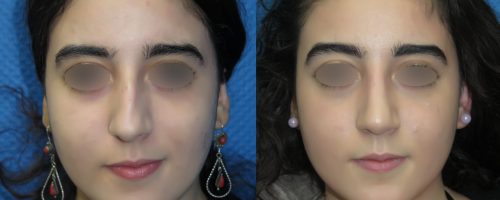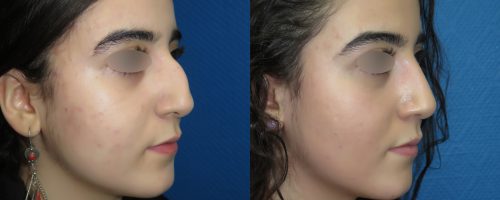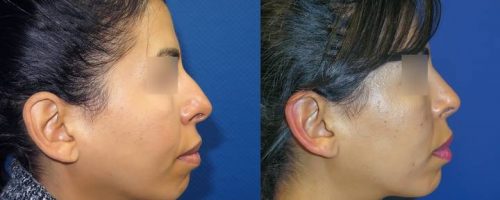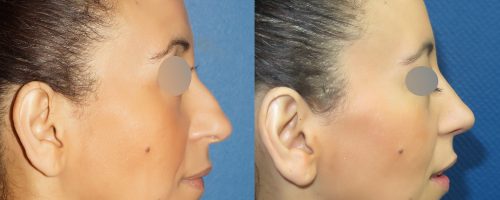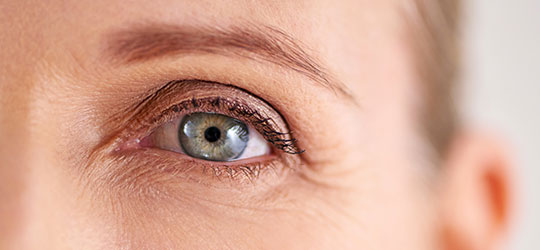Rhinoplasty is a surgery of the nose that changes its shape or corrects functional issues.
It is one of the most challenging and meticulous surgeries because of the importance of the nose in the balance of the face.
A corrective and/or a functional rhinoplasty gives the best results when the patient and the plastic surgeon share the same vision on the outcome. The patient must feel comfortable with the plastic surgeon, discuss his needs, tell him his expectations and find an agreement over what result is possible to reach.
- Painless surgery
- The outcome will be the best nose your nose will allow to give
- Esthetic or Reconstructive nose surgery
- It may take up to one year to see the final result
GENERAL DESCRIPTION OF ESTHETIC RHINOPLASTY
This information sheet is issued by Dr Vincent Nguyen board-certified plastic surgeon in Paris, familiar with Rhinoplasty. It provides all the information about the surgery, scars, recovery, before and after comparison photographs, Social Security or Health Insurance Company coverage or reimbursement and the costs of rhinoplasty.
What is Rhinoplasty?
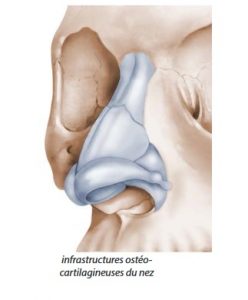
Rhinoplasty is a surgery that changes the shape of the nose for esthetic or functional reasons (to help breathe more easily).
Patients undergo Esthetic Rhinoplasty to correct an esthetic concern due to a birth defect or to aging.
In case of a trauma or after nasal injuries, patients undergo a reconstructive nose surgery to give their nose a natural and normal appearance.
What are the different types of nose surgery?
There is esthetic rhinoplasty, corrective rhinoplasty and reconstructive rhinoplasty.
There is also primary rhinoplasty (first nose job) and revision rhinoplasty (second, third, fourth or even more nose jobs) that is more challenging on a multi-operated nose.
Rhinoplasty may also be partial, only the tip of the nose is addressed, ethnic (Asian, African…) and medical (nose job with fillers) without surgery.
What result is possible?
Depending on the expectations of the patient and what was agreed during the consultation, the plastic surgeon can reduce the size of a large nose, shorten a long nose, change the shape of the tip, modify the contour of the bridge by correcting a bump or correct a deviated septum.
THE PRINCIPLES OF RHINOPLASTY
What is the goal of rhinoplasty?
People get a nose job to improve the appearance of their nose, to create a natural balance and harmony to the face.
The plastic surgeon must make sure that it also matches the personality and psychology of the patient to achieve the best possible natural outcome.
LES ÉTAPES D’INTERVENTIONS D’UNE CHIRURGIE DU NEZ
BEFORE RHINOPLASTY SURGERY:
- Two preoperative consultations with a board-certified plastic surgeon will be conducted before rhinoplasty surgery as well as a consultation with an anesthetist.
- Before and after comparison photographs will be taken.
- Morphing may be used to simulate global approach of the result.
- The preoperative instructions are as follow:
- Quit smoking a minimum of one month before the surgery to one month after the surgery to reduce any complications and avoid necrosis risk.
- Discontinue any anti-platelet or blood-thinning medication 2 weeks before the surgery.
RHINOPLASTY SURGERY:
- Rhinoplasty is performed under general anesthesia.
- The surgery may last one to more than three hours depending on the defects to correct.
- Dr Vincent Nguyen uses the most advanced techniques and performs the surgery himself.
2 to 3 months will be needed for the swelling to resolve and to get an overview of the final result. The healing process takes time and it isn’t until a full year that the shape of the nose is definitive.
AFTER RHINOPLASTY SURGERY:
- A nose job is not a painful surgery but you’ll feel uncomfortable not to be able to breathe through the nose in the days following the procedure.
- Patients leave the same day after a few hours at the clinic or the following morning.
- Eyelid edema and bruising will fade within a few days, depending on the patient’s reaction to the procedure.
- The wicks are removed the next day by Dr Vincent Nguyen.
- The splint will be removed between the 5th to the 8th day after the surgery, along with the stitches.
- The nose is still swollen the following days because of edema, and nasal breathing is uncomfortable due to swelling of nasal mucus membranes and to crusts.
- Social activities may be resumed 10 to 15 days after surgery.
- Follow-up appointments with Dr Vincent Nguyen will be scheduled 1 week, 1 month, 3 months, 6months and 1 year after the surgery.
- Sports and strenuous activities will be prohibited the first 3 months following the surgery.
- Protect your nose from the sun as long as bruising remains.
Rhinoplasty: price and costs
- When Rhinoplasty is an esthetic procedure, it is not covered by Social Security or Health Insurance Company.
- Reconstructive Rhinoplasty or Rhinoplasty for functional disorders (congenital or caused by a trauma) or for congenital malformations, may be reimbursed with the prior approval of Social Security or Health Insurance Company.
- If Social Security doesn’t agree on a reimbursement, it is considered as an esthetic rhinoplasty instead of reconstructive surgery.
- The costs may vary depending on the patient, if Social Security approves the procedure partially or totally, or not.
- It also depends on the procedures combined with the nose job, on the techniques chosen for the surgery, the type and complexity of the procedure performed, on the location where the procedure will be performed, on the length of the procedure and other related expenses.
- The cost may vary from …to … (see all the costs of esthetic procedures on this website).
- Make sure to find a board-certified plastic surgeon specialized in nose jobs who will evaluate your needs, discuss your expectations and your options, and advise you on the procedures, to deliver the best natural-looking results to enhance the harmony of your face.
QUESTIONS FRÉQUENTES SUR LA CHIRURGIE DU NEZ
What about scars?
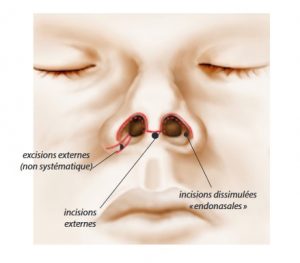
There are no visible scars after a nose job.
The incisions are hidden inside the nostrils for a closed rhinoplasty, through the columella (skin separating the two nostrils) for an open rhinoplasty, or hidden in the folds at the base, the sides of the nose if the goal is to reduce the size of nostrils (see picture).
The bone and cartilage are sculpted to a new shape through these incisions. Sometimes grafts of cartilage are used to fill a depression, support a part of the nose or improve the shape of the tip. The skin will redrape over the new shape due to its elasticity.
Can rhinoplasty address breathing issues?
Some patients requiring rhinoplasty also complain of breathing discomfort due to a deviated nasal septum or to a hypertrophy of the nasal turbinates. Rhinoplasty is then combined with septoplasty and/or turbinate surgery.
What other procedures may be combined with a nose job?
Rhinoplasty may be combined with genioplasty (chin surgery) to improve the profile of the patient in a spectacular way.
Any other face surgery may be combined with rhinoplasty: blepharoplasty, neck lift, lipofilling, or any esthetic medicine procedure: peeling, Botox, Hyaluronic Acid injections…
What are the alternatives to Rhinoplasty?
Medical rhinoplasty (esthetic medicine) may, in some rare cases, replace a surgical procedure. Dr Vincent Nguyen may suggest injections of Hyaluronic Acid if he thinks it is adapted to the patient’s needs.
What is the interest of morphing?
Computer morphing is very helpful before a nose job as the plastic surgeon uses computer software to touch up photos, to show the patient what surgical results may be achieved with his nose, before the surgery. The virtual pictures obtained help reach a global approach of the outcome.
It enables the plastic surgeon to make his patient understand that his nose must be in harmony with the rest of his face and that certain nose shapes won’t suit his face.
However, Morphing is only a tool, a virtual picture. It is a global approach, not the exact outcome. It helps the patient to better understand what can be done to reach the best natural result in harmony with his face.

